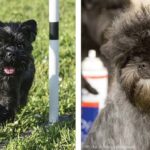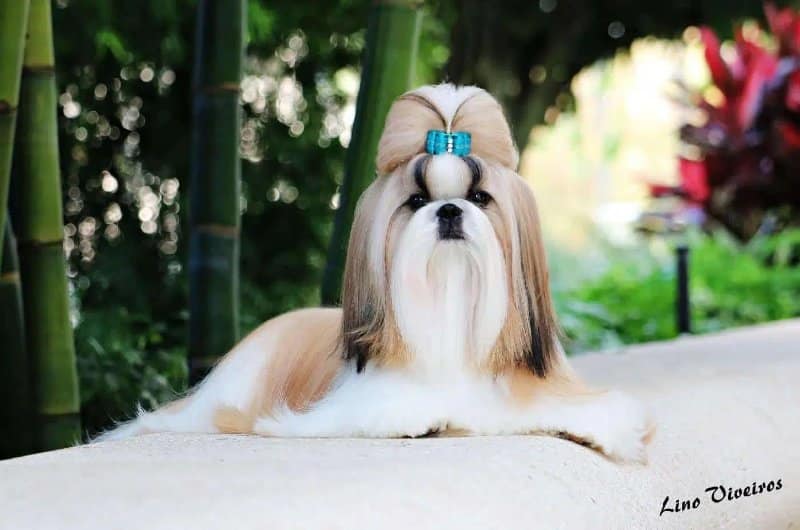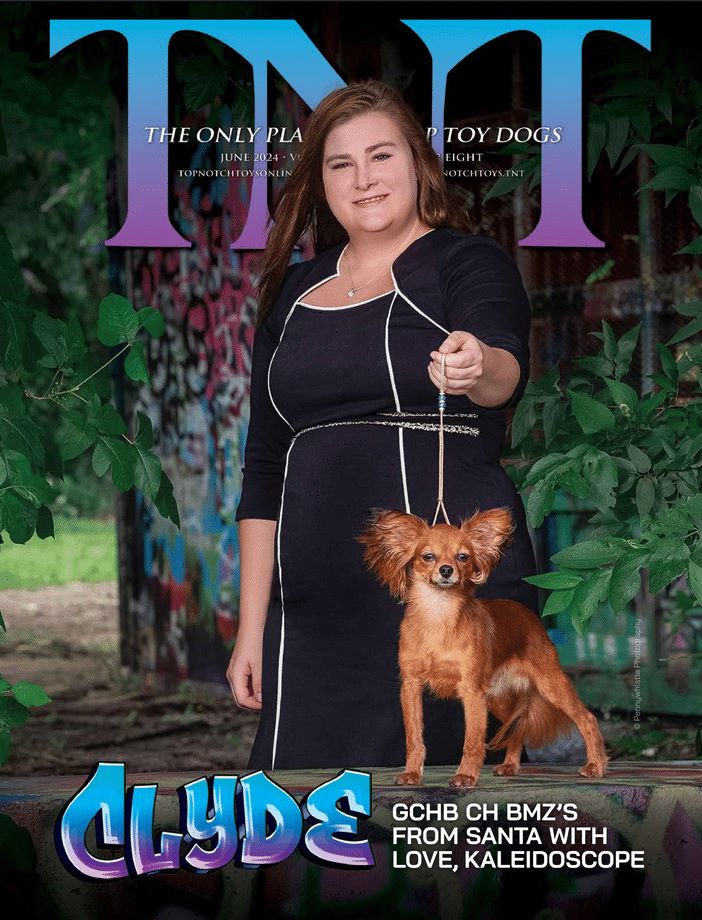Judging the Shih Tzu can be a challenging task for the newly approved Breed judge. Because the Shih Tzu is a heavily-coated breed, one must take extra care during the hands-on examination.
Please judge the Shih Tzu by the AKC standard and not by the name of the Group it is placed in. Being a member of the AKC Toy Group in no way implies that “smaller” and “cuter” are preferred. Breeders and judges should remember that most everywhere else in the world the Shih Tzu is not in the Toy Group. The Shih Tzu has not been bred down from some other combination of breeds.
The Shih Tzu should be the third heaviest breed in the Toy Group, right behind the Pug and the Cavalier King Charles Spaniel. At the time of recognition, one reason given for placing the Shih Tzu in the AKC Toy Group was to eliminate confusion between the Shih Tzu and the Lhasa Apso.
A few years ago, when AKC Group realignment was being considered, the membership of the ASTC was polled and the desire of the overwhelming majority was to remain in the Toy Group. Some members just wanted to leave things the way they were. Some members feared the breed would get larger if placed in the Non-Sporting or the proposed Companion Group.
In Canada, the Shih Tzu is in the Non-Sporting Group and Canadian Shih Tzu are no larger than American-bred Shih Tzu. In fact, the Canadian dogs compete very well at our national specialties. Many Americans breed to Canadian dogs. Some ASTC members did not want to be placed into the same Group with Poodles and Bichon, which tend to dominate Group winning there.
An interesting note about the English Shih Tzu Standard: The original English standard stated, “The Shih Tzu is neither a Terrier, nor a Toy.” It bears repeating; judge the Shih Tzu by the AKC standard and NOT by the name of the Group it is placed in.
Judging The Shih Tzu – Type Over Soundness
The Shih Tzu should move as soundly as any other breed: Sound coming and going, with a level topline and good reach and drive. But do not put physical and structural soundness ahead of type. Remember form over function, and the function of a Shih Tzu is to be a beautiful, pleasing companion. Please find the typiest dogs in the ring and then reward the soundest of the typiest.
Judging The Shih Tzu – The Influence of Sex
There is little difference in appearance and size of males and females. Both sexes have been big winners, including multiple National Specialty and Best In Show winners.
Judging The Shih Tzu – Manhandling Shih Tzu
There is no reason to ever be heavy-handed when judging the breed. Temperamentally, Shih Tzu can “take being man-handled,” but there is absolutely no reason to squeeze the legs all the way down to the toes. It is possible to ascertain what is underneath the hair without squeezing.
Judging The Shih Tzu – Grooming
The Shih Tzu is just as much a “grooming breed” as the Yorkshire Terrier, the Maltese, the Poodle and the Terrier breeds to name a few…Grooming and presentation are important. Excesses are not acceptable. Grooming techniques have evolved over the years, often to the detriment of the breed. Anyone approved by AKC to judge any breed knows what the AKC rules are, and what is and is not allowed. You all know what your options are and how to deal with it.
I find it difficult to penalize a dog for what a human has done to it. Regarding the Shih Tzu Standard, there is nothing specific in the standard as to “how” the topknot is supposed to be “prepared.” The standard simply says, “Hair on top of head is tied up.” In fact, the standard prior to 1989, simply said, “Hair…may be tied up.” Notice there is nothing specific as to what the topknot should look like or how many bands may be used, etc. If you as a judge find something excessive, you will have to deal with it as you see fit. I would suggest though, that if you are going to penalize Shih Tzu for perceived grooming abuses, I ask that you be just as consistent with other highly-groomed breeds.
Before the ‘90s, almost all topknots were tied up with a dental ligature and split, with the hair flowing down both sides of the head. The Shih Tzu has a habit of shaking violently when first coming off the table, which leaves the hair flying in all directions, but especially over the face. To minimize the effects of shaking, exhibitors began to shorten the topknots. As time passed, other techniques were employed to keep the hair in place. Some feel the reason topknots have gotten “higher” is to give the appearance of more neck. This may or may not be the reason. Some feel that this ability to manufacture an intricate topknot gives the expert groomer an advantage over the average breeder/exhibitor. To be sure, some feel these intricate topknots are a way of intimidating the judge from really examining the head.
Most Shih Tzu exhibitors believe they would not win if they did not use the “modern” topknot. I was recently told that on one occasion an exhibitor using the “old fashioned” topknot was told by a judge to go to the other exhibitors who could teach them how to “do up” the topknot the correct way. I prefer the split style topknot, but the style in which an entry is presented would have almost no effect on my judging or placements. There are simply too many other aspects of the breed that are more important and critical.
Recently, I was critical of the tail of a Terrier I was judging and did not reward it a win. When I stated this to a breed expert, I was asked, “What about the dog in front of the tail?” Again, the standard states, “Care should be taken to look and examine well beyond the hair to determine if what is seen is the actual head and expression rather than an image created by grooming technique.” Regarding trimming, the standard says, “Trimming—Feet, bottom of coat and anus may be done for neatness and to facilitate movement. Fault: Excessive trimming.”
The most important characteristics to keep in mind while judging these beautiful dogs are: Temperament, Balance, Heads, Body, Coat and Color, and Movement.
Judging The Shih Tzu – Temperament
In judging Shih Tzu, temperament should never be an issue. This is a happy breed, which would rather kiss you than have you examine it. A bit of happy “naughtiness” should be expected. Please do not expect the Shih Tzu to be a robot. At the same time, any hint of shyness should be noted and considered when making your decisions. Aggressiveness, as in any other breed, is not to be tolerated.
Judging The Shih Tzu – Balance & Proportions
The Shih Tzu is a rectangular breed. The distance from the withers to the set of the tail is “slightly” longer than the distance from the withers to the ground. The limits for height are from 8″ to 11″; ideally from 9 to 10-1/2″. Therefore, if a dog’s height measures 10-1/2″ at the withers, the distance from the withers to the set of the tail should be approximately 10-3/4″. When you add forechest and buttocks to the trunk section, you have a distinctly rectangular dog.
Judging height-to-length balance is done best on the table, (where all dogs in the Toy Group must be examined). Judging Shih Tzu outdoors on grass will add at least an inch or more to apparent overall length and, of course, will distort the true balance and make the dog look much longer than it really is. Toy exhibitors frequently complain that the grass is never mowed short enough. On a flat surface this is much less of a problem. Of course, judging the breed in the wind and rain creates a real disaster.
When looking at a class of dogs, look at where their toplines are and not at the top of their heads. Typically, a dog with good shoulders will carry himself more upright and might appear to be taller. Begin your examination by getting a sense of the overall balance from the side, looking at and comparing all the entries in a class. I always take a single dog or an entire class around the ring before tabling for examination. If you feel it necessary to re-examine any aspect of a Toy dog, re-table the dog. It is permissible to put no more than two at a time on the table to make comparison. As with some other Toy breeds, having the handler pick the dog up to eye level for examination to re-check details of the head is permissible.
Judging The Shih Tzu – The Head
The head is the hallmark of the breed. Though no breed walks on its head, large, correctly-placed and spaced eyes and a strong underjaw are two key ingredients in establishing breed type. The head should be large in proportion to the body. The breed has lost head size, but what is more alarming is that most dogs’ heads are nearly flat between the ears. When you find a Shih Tzu with a large head, reward it (providing other key breed characteristics are present).
There should be good “doming” above the eyes and between the ears. The head should be round when viewed from the front or from the side. The muzzle should be broad and square from the front and perpendicular when viewed from the side. If the profile of the muzzle is perpendicular, the mouth will not be too undershot. The nostrils should be wide open. The teeth, ideally, are straight, but the width of the jaw (per the standard) is more important than slightly misaligned teeth or a missing tooth.
The “Persian Kitten” syndrome (a look in which the face is small with the muzzle pinched, with small nose leather and the entire muzzle turned up) is very incorrect. The Shih Tzu should never give that impression when viewed straight on. Please check the eye/nose placement not only from the front, but also from the side. The eyes are large and as dark as possible; set wide apart with the bridge of the nose no lower than the bottom of the eye sockets, with as little eye white as possible. Do not discard an otherwise good specimen of the breed because of a very small amount of white in the inside corner of the eye. An eye totally ringed in white is completely unacceptable.
Today, a Shih Tzu with a big, broad head with plenty of doming is more the exception than the rule. The nose leather (not length) should be large and black with wide open nostrils. If you must choose between “down faced” or a nose placed too high, choose the latter. The Shih Tzu should have a broad lower jaw with reverse scissors bite. Most mouths today are proper. There are very few wry or severely undershot bites. Sometimes the teeth are a little out of alignment or there might be a tooth missing. The standard allows for this. The standard does not call for full dentition and there is no reason to look any farther than across the front of the mouth.
By looking at the canines and incisors, you will be able to tell whether the dog has the proper undershot bite and whether the mouth is wry and how broad the jaw is. What is most important is that the jaw is broad and the under-jaw is strong. A broad, strong under-jaw is a key to the essence of head type in the breed.
Judging The Shih Tzu – The Hands-On Examination
Do not be intimidated by grooming. It is easy to examine the Shih Tzu thoroughly without disturbing the grooming at all.
To examine the head, cup the head with your hands and fingers behind the jaws and ears. With your thumbs, check the ear set to see if the ears are set just below the crown of the head and to see if there is “doming between the ears.”
Use either thumb to determine the depth of the stop and the length of the nose. Using either thumb, push inward on the topknot (between the bow and the stop) to see if there is sufficient skull forward. Often the skull falls away above the eyes, with practically no fore-skull. Run both thumbs down each side of the muzzle and mustache to determine the width. Using either hand, hold down on the beard below the lower lip and push the lips upward with the other hand to examine the bite. Remember, the width of the jaw is more important than misaligned teeth or a missing tooth. Check the muzzle from the side.
Judging The Shih Tzu – The Body
After finishing your examination of the head, move your hands to the shoulders (it is a good idea to stay in contact with the dog as you move your hands to the shoulders). Run your hands down the forequarters, checking for normal shoulder layback. The forelegs should be straight, though you will seldom find perfectly straight legs in the Shih Tzu. The remainder of the physical examination of the Shih Tzu is like that of most other breeds. Do not massage (stroke) the coat back and forth along the spine. There should be good bone, good substance and good spring of rib.
In fact, the standard states, “Substance—Regardless of size, the Shih Tzu is always compact, solid and carries good weight and substance.” The standard does not say, “For its size,” but says, “Regardless of size must have those characteristics.” Though the Shih Tzu standard has no DQ for weight, it is good to know what a breeder expects. Weight goes from 9 to 16 pounds. Most breeders would agree that they would like their males to be about 12 to 14 pounds and bitches to be more like 11 to 13 pounds.
Don’t confuse a huge coat for substance. Some “apparently big” dogs (because of the amount of coat they have) can in reality be very “shelly” and an apparently smaller dog in reality might have very good bone and wonderful rib spring. The only way to know for sure is with the physical examination. In other words, don’t confuse height or coat alone for big or little.
Judging The Shih Tzu – Coat
The standard calls for a long, luxurious “double coat.” When examining the coat texture, feel the coat between your fingers to determine the texture. Do not massage (stroke) the coat back and forth along the spine. The same would go for any other drop coat breed. Lay the tail back to see if it is set-on high. There should be no rounding of the croup. Also, determine whether the tail lays flat on the back or is more like a teapot handle. There should be room for you to slide your hand between the tail and the dog’s back when the tail curls over the side. The tail is set on high; arching well over the back and not carried tightly over the side of the dog or lying flat on the back. Step back to determine the shape of the dog.
Judging The Shih Tzu – Color & Markings
Parti-colored, solid any color, black and white or having a dark face is of no importance, as all colors and markings are equal. All colors and markings are acceptable and equal. It is more difficult to judge dark-faced or solid-colored dogs because the breed’s facial characteristics do not “pop out at you.” This is why a careful, up close examination (on the table) is so important. There are no official records kept for the all-time top-winning parti-colored, black masked gold or solid black Shih Tzu.
Resist the temptation to have a color preference; to prefer black and white, solid black or black masked gold dogs. Do not be turned off by a mismarked beard (black on one side and white on the other). There are breeders who prefer certain colors or markings but, as a judge, you must treat all colors and markings as acceptable and equal.
A word about the colors blue and liver: They are acceptable according to the standard. However, Shih Tzu with these colors frequently also have lighter eyes; though not always. This creates a problem in that it is more difficult to get soft, warm expression from a lighter eye. Liver pigment is seldom seen in the ring and blue is a real rarity.
Judging The Shih Tzu – Movement
The last component of type, Shih Tzu movement should be the same as for any soundly moving dog. The head should be carried high. The standard refers to a “distinctly arrogant carriage.” There is absolutely no mention in the standard about length of neck. The standard requires that the Shih Tzu have arrogant carriage. In order for a Shih Tzu to carry its head high (without being “strung up”), it must have good shoulder layback. Moving away from you, you should see two black pads. The Shih Tzu should cover ground, but is not to be raced.
The standard states, “The Shih Tzu moves straight and must be shown at its own natural speed, neither raced nor strung-up.” Enough tension on the lead to guide the Shih Tzu is appropriate. A dead loose lead is not necessary. However, please discourage exhibitors from stringing up their dogs. When I see abuse in this area, I usually ask the exhibitor to “move your dog again, this time slower and please let up on the lead.”










